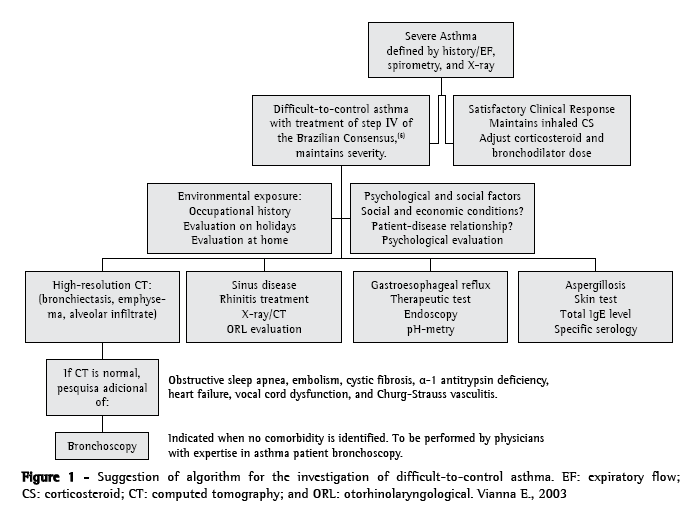



Ana Carla Sousa de Araujo, Érica Ferraz, Marcos de Carvalho Borges, João Terra Filho, Elcio Oliveira Vianna
ABSTRACT
Objective: To determine the prevalence of factors associated with difficult-to-control asthma. Methods: Patients with severe asthma were selected from the outpatient asthma clinic of the Ribeirão Preto School of Medicine Hospital das Clínicas. The patients were divided into two groups: controlled severe asthma and difficult-to-control severe asthma. After new attempts to optimize the severe asthma treatment, a questionnaire was applied, and additional tests for factors associated with difficult-to-control asthma, such as environmental and occupational exposure, smoking history, social factors, rhinitis/sinusitis, gastroesophageal reflux disease (GERD), obstructive sleep apnea, congestive heart failure (CHF), pulmonary embolism, cystic fibrosis, vocal cord dysfunction, α-1 antitrypsin deficiency, and Churg-Strauss syndrome, were performed. Results: 77 patients with severe asthma were selected, of which 47 suffered from hard-to-control asthma, being 68.1% female, with mean age of 44.4 years (±14.4), and forced expiratory volume in one second of 54.7% (±18.3). The most factors most often associated with difficult-to-control asthma were noncompliance with treatment (68%), rhinitis/sinusitis (57%), GERD (49%), environmental exposure (34%), occupational exposure (17%), smoking history (10%), obstructive sleep apnea (2%), and CHF (2%). At least one of these factors was identified in every case. Conclusions: Noncompliance with treatment was the factor most often associated with difficult-to-control asthma, underscoring the need to investigate comorbidities in the evaluation of patients with this form of the disease.
Keywords: Asthma; Smoking; Gastroesophageal reflux; Patient compliance; Rhinitis; Sinusitis.
RESUMO
Objetivo: Pesquisar a freqüência dos fatores associados à asma de difícil controle. Métodos: Foram selecionados pacientes com diagnóstico de asma grave do ambulatório de asma do Hospital das Clínicas da Faculdade de Medicina de Ribeirão Preto. Os pacientes foram classificados em dois grupos: asma grave controlada e asma grave de difícil controle. Após nova tentativa de otimização do tratamento para o grupo de difícil controle, foram aplicados questionário e investigação complementar de fatores associados, como exposição ambiental domiciliar e ocupacional, tabagismo, fatores sociais, rinossinusite, doença do refluxo gastroesofágico (DRGE), apnéia obstrutiva do sono, insuficiência cardíaca congestiva (ICC), embolia pulmonar, fibrose cística, disfunção de cordas vocais, deficiência de α-1 antitripsina e vasculite de Churg‑Strauss. Resultados: Foram selecionados 77 pacientes com asma grave, dos quais 47 apresentavam asma de difícil controle, sendo 68,1% do sexo feminino, idade média de 44,4 anos (±14,4) e volume expiratório forçado no primeiro segundo de 54,7% (±18,3%). Dos diagnósticos encontrados em associação à asma de difícil controle, o mais freqüente foi a pouca adesão ao tratamento (68%). Outros foram as más condições ambientais (34%) e ocupacionais (17%), rinossinusite (57%), DRGE (49%), apnéia obstrutiva do sono (2%), ICC (2%) e tabagismo (10%). Em todos os casos, pelo menos um desses fatores concomitantes foi diagnosticado. Conclusões: O fator mais freqüente associado à asma de difícil controle nos indivíduos estudados é a pouca adesão à medicação prescrita. A investigação de co-morbidades é imperativa na avaliação de pacientes com esta forma da doença.
Palavras-chave: Asma; Tabagismo; Refluxo gastroesofágico; Cooperação do Paciente; Rinite; Sinusite.
Introduction

